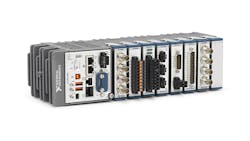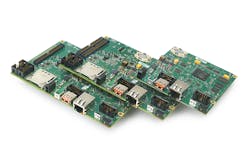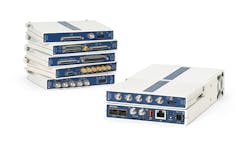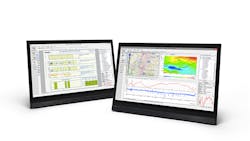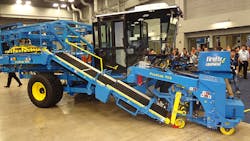National Instruments (NI) always saves its big announcements for NI Week and this year was no different, making it a very interesting show. LabVIEW 2015 took center stage along with a host of new hardware options including CompactRIO, FlexRIO, and CompactDAQ controllers.
The new CompactRIO Controllers (Fig. 1) are based on Intel's 1.91 GHz Atom quad-core E3845 processor along with Xilinx's Kintex-7 FPGA (see “Xilinx Unifies FPGA Line” on electronicdesign.com). CompactRIO now runs the 64-bit NI Linux Real-Time operating system. It can run LabVIEW applications as well as applications written in other languages to run on Linux. The system has its own Embedded UI for local HMI support. The systems have on-board non-volatile storage as well as removable Secure Digital (SD) storage.
The Single-board RIO (SBRIO) family (Fig. 2) is now based on Xilinx Zynq system-on-a-chip (see “FPGA Packs in Dual Cortex-A9 Micro” on electronicdesign.com). It runs NI Linux Real-Time. The SBRIO boards use the same RIO mezzanine card connector, allowing interchangeability. They have gigabit Ethernet connectivity as well as USB, RS-232 and CAN support.
FlexRIO Controller (Fig. 3) also uses the Xilinx Kintex-7 FPGA and runs LabVIEW applications. The controller provides a migration path from PXI as a deployable platform. The controller accepts a FlexRIO Adapter Module. NI has a large selection of modules from RF transceivers to ADCs/DACs and a Camera Link module. There are third-party modules and developers can design custom modules.
NI has been known for its data acquisition tools, so it was no surpise to see the new 4- and 8-slot CompactDAQ controllers (Fig. 4) featuring a 1.91 GHz, Intel Atom quad-core E3845 processors. The controllers can run Windows Embedded 7 or NI Linux Real-Time. The systems include 32 Gbytes of nonvolatile storage as well as removable SD storage. They have two integrated USB ports, two Gigabit Ethernet ports, an RS232 serial port, a trigger input, and a user-configurable button input. They are ideal for smart data loggers and embedded monitoring applications. NI also released a 14-slot USB 3.0 CompactDAQ Chassis.
On the software side, NI released its DIAdem 2015 (Fig. 5) software and DataFinder Server Edition 2015 platform. These are designed to support NI's version of IoT support called “Big Analog Data.” This version of DIAdem is a 64-bit release that can load and analyze more data. DIAdem VIEW has a new display mode called Cascade that can display waterfalls and calculate and display order lines. The system has improved search capabilities to globally find specific data sets for analysis as well as additional data visualizations and analysis functions.
There was a host of products on display that used the platforms like CompactRIO and SBRIO. One of the larger ones was Firefly Equipment ProSlab 155 turf harvester (Fig. 6). It runs LabVIEW applications on CompactRIO controllers to monitor and provide remote control support. It is highly automated and is 20 percent more productive while using half the fuel of other slab machines.
About the Author
William G. Wong
Senior Content Director - Electronic Design and Microwaves & RF
I am Editor of Electronic Design focusing on embedded, software, and systems. As Senior Content Director, I also manage Microwaves & RF and I work with a great team of editors to provide engineers, programmers, developers and technical managers with interesting and useful articles and videos on a regular basis. Check out our free newsletters to see the latest content.
You can send press releases for new products for possible coverage on the website. I am also interested in receiving contributed articles for publishing on our website. Use our template and send to me along with a signed release form.
Check out my blog, AltEmbedded on Electronic Design, as well as his latest articles on this site that are listed below.
You can visit my social media via these links:
- AltEmbedded on Electronic Design
- Bill Wong on Facebook
- @AltEmbedded on Twitter
- Bill Wong on LinkedIn
I earned a Bachelor of Electrical Engineering at the Georgia Institute of Technology and a Masters in Computer Science from Rutgers University. I still do a bit of programming using everything from C and C++ to Rust and Ada/SPARK. I do a bit of PHP programming for Drupal websites. I have posted a few Drupal modules.
I still get a hand on software and electronic hardware. Some of this can be found on our Kit Close-Up video series. You can also see me on many of our TechXchange Talk videos. I am interested in a range of projects from robotics to artificial intelligence.
